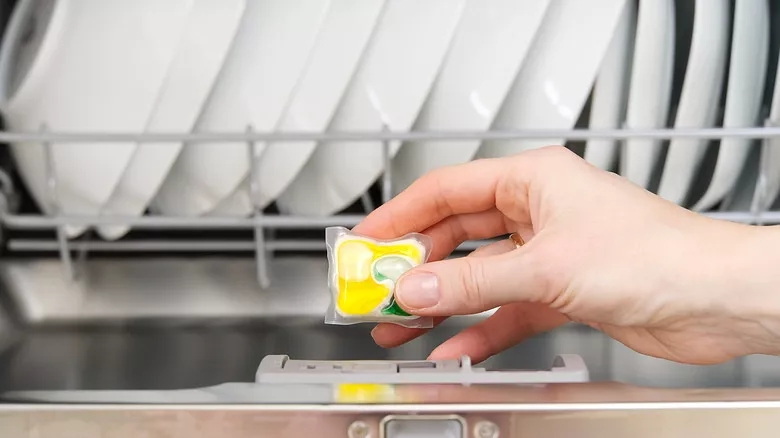Dongguan UFine Daily Chemical Co.,Ltd.
- All
- Product Name
- Product Keyword
- Product Model
- Product Summary
- Product Description
- Multi Field Search
Views: 222 Author: Tomorrow Publish Time: 10-17-2025 Origin: Site











Content Menu
● Understanding the Difference Between Laundry Pods and Dishwasher Detergent
● What Happens When You Use Laundry Pods in a Dishwasher?
● Why Laundry Pods Are Not Suitable for Dishwashers
>> Packaging and Release Mechanism
>> Environmental Considerations
● What Should You Use Instead?
● How to Handle an Accidentally Used Laundry Pod in Dishwasher
● Additional Risks of Misusing Laundry Pods in Dishwashers
>> Increased Water Use and Energy Waste
● FAQ
>> 1. Can I use laundry pods as a substitute for dishwasher detergent?
>> 2. What immediate actions should I take if I use a laundry pod in the dishwasher?
>> 3. Do laundry pods harm my dishwasher permanently?
>> 4. Why do laundry pods create more foam than dishwasher detergents?
>> 5. What is the safest detergent option for dishwashers?
Laundry pods and dishwasher detergents are specially formulated to work in their respective machines. Using one type of pod in the other device can lead to various consequences, from ineffective cleaning to damage to appliances. This article explores what happens if you use laundry pods in a dishwasher, the risks involved, and safer alternatives to avoid issues.

Laundry pods and dishwasher detergents are designed for different cleaning tasks and environments. Laundry pods typically contain surfactants, enzymes, and stabilizers tailored to remove stains and dirt from fabrics in a washing machine. Dishwasher detergents focus on breaking down food residues and protecting dishwasher parts from hardness and mineral buildup.
- Laundry Pods: Contain fabric-safe enzymes, surfactants for greasy and protein stains, brighteners, and softeners.
- Dishwasher Detergents: Include high-pH agents, anti-corrosion components, and rinsing aids suitable for dishes and glassware.
Using laundry pods in a dishwasher can result in an imbalance of cleaning agents that are not ideal for dishwashing purposes.
Laundry pods are formulated to generate a lot of foam to clean clothes effectively. When used in a dishwasher, the excessive soap suds can overflow from the dishwasher, leading to:
- Leakage under the dishwasher
- Foam buildup inside and around the appliance
- Potential water damage to your kitchen floor
The foam can also get into areas of the dishwasher that should remain dry, potentially causing malfunction or short circuits in electronic components.
Since laundry pods do not contain agents designed to remove food residues, grease, and mineral deposits typical in dishwashing, the outcome will often be:
- Poor cleaning performance on dishes and utensils
- Residual detergent film left on glassware or plates
- Lingering odors after washing
This means your dishes may remain dirty or cloudy, defeating the purpose of running the dishwasher.
The ingredients in laundry pods may adversely affect the dishwasher's internal components, including:
- Damage to dishwasher seals due to unsuitable chemicals that can degrade rubber or plastic parts
- Clogging in the spray arms or filters because of foamy residue
- Accelerated wear and tear of dishwasher mechanisms, potentially shortening the appliance's lifespan
Dishwashers are made to handle specific detergents. Introducing chemicals not meant for the machine can disturb its operation and lead to costly repairs.
Another important factor is safety. Residues from laundry pods may not rinse off completely and could contaminate dishes, posing health risks when food comes into contact with these chemicals. The detergents in laundry pods are not food-safe and may contain fragrance or additives unsafe to ingest. This risk makes it essential to avoid using laundry pods in dishwashers.

Laundry detergents prioritize fabric care and stain removal, often including bleach and optical brighteners not recommended for dishes. Dishwashers require a different chemical balance to ensure effective food residue removal without damaging dish surfaces or the machine. The pH levels and enzyme types differ significantly, which makes laundry pod ingredients incompatible for cleaning dishes.
Dishwasher pods dissolve at a steady pace suitable for dishwashing cycles, while laundry pods might dissolve too quickly or inconsistently in the dishwasher environment, causing poor results and machine issues. Improper dissolution can leave detergent residue, increase foam, or prevent proper cleaning stages.
Laundry pods often contain components that are not designed to be fully biodegradable in aquatic systems targeted by dishwasher wastewater treatment. Using them in dishwashers can contribute to unnecessary environmental harm compared to using proper dishwasher detergents formulated for responsible waste treatment.
Always use detergents formulated specifically for dishwashers, such as:
- Dishwasher detergent pods or tablets, engineered to provide thorough cleaning and minimal suds
- Powder detergents, offering flexibility in dosing and effective performance
- Liquid dishwasher detergents, ideal for pre-treating or smaller loads
To improve cleaning and drying performance, using rinse aids alongside dishwasher detergents is recommended. Rinse aids prevent water spotting and help eliminate detergent residues that could cloud dishes.
- Regularly clean the dishwasher filter and spray arms
- Use dishwasher cleaning cycles to remove buildup
- Use water softeners if your water hardness is high, which can improve detergent effectiveness
Proper maintenance enhances detergent performance and extends the life of your dishwasher.
If you accidentally use laundry pods in your dishwasher, follow these steps:
1. Stop the dishwasher cycle immediately to prevent further foam and damage.
2. Open the dishwasher carefully. Remove any visible pods or detergent accumulations.
3. Wipe down the interior, focusing on seals, spray arms, and filters where residue might accumulate.
4. Run a rinse cycle using dishwasher detergent or a mild vinegar solution to clear remaining residues and neutralize chemicals.
5. Monitor the dishwasher for leaks or unusual noises in future cycles to catch any damage early.
6. If excessive foam continues, repeat the rinsing process until clear.
Taking these steps quickly can minimize damage and help maintain dishwasher functionality.
Because you may have to rerun cleaning or rinsing cycles due to poor washing results, using laundry pods can indirectly cause more water and energy consumption. This inefficiency increases household costs and environmental footprint.
Many dishwasher manufacturers specify using only dishwasher-specific detergents. Misusing laundry pods can void warranties, leaving you responsible for repairs.
Using laundry pods in a dishwasher is not advisable due to chemical differences, excessive foam production, ineffective cleaning, and potential damage to the appliance. Laundry pods are designed for fabric and include ingredients that cause foaming and chemical imbalances unsuited for dishwashing needs. Always use products formulated for dishwashers to ensure cleanliness, safety, and machine longevity. Handling accidents promptly by stopping the cycle, cleaning out residues, and running proper rinse cycles can help minimize damage if the wrong pod is used.

No, laundry pods are not designed for dishwashers and can cause excessive foam, poor cleaning, and damage to the appliance.
Stop the cycle, remove detergent residue, clean the dishwasher interior, and run a rinse cycle with proper detergent or vinegar.
They can cause damage over time, especially to seals and filters, due to their chemical makeup and excessive foaming.
Laundry pods contain strong foaming agents intended to clean fabrics, whereas dishwasher detergents are formulated to avoid suds to protect the machine.
Dishwasher-specific detergent pods, tablets, powders, or liquids combined with rinse aids are the safest and most effective cleaning options.